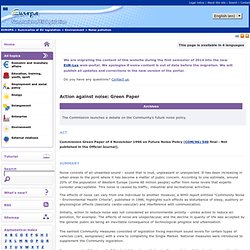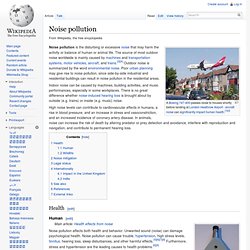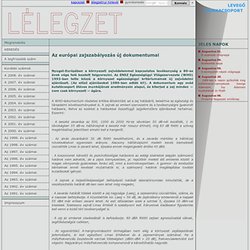

Untitled. Noise Pollution Law in Europe « Pollution Free Cities. Posted on December 30, 2010 by pollutionfree European Court tackles unacceptable traffic noise pollution (Strasbourg Observers, Dec. 1, 2010) Also discussed here: Night noise guidelines for Europe (162 page pdf, World Health Org., 2009) A recent ruling by the European Court found that the state had not done enough to provide a citizen’s “right to respect for his private life and home”.

The EU has shown leadership in producing guidelines and legal opinions that focus on health impacts of noise, especially in urban settings. Key Quotes: “Traffic noise pollution – especially at night – is one of the biggest health risks of contemporary Europe. “Although the right to a quiet and healthy environment is not incorporated in the Convention, it is settled case-law that environmental pollution, such as noise, emissions or smells, can amount to an interference with the right to respect for someone’s private life and home” Like this: Like Loading...
Noise. A Swiss communication campaign promoting the use of better tyres has won the European Soundscape Award 2013.

The prize, presented by the European Environment Agency (EEA) and the Dutch Noise Abatement Society at the Gouden Decibel Award Ceremony in the Netherlands Tuesday evening, recognises initiatives that can help cut noise and create more attractive acoustic environments. Do you want to make some noise about your campaign for a quiet environment? Or do you want to show others how your community solved a noise problem and created a healthier soundscape? The European Soundscape Award 2013 aims to draw attention to these kinds of projects. Bp_Intezkedesi_terv_osszefoglalo. Facts and figures. Noise is an underestimated threat that can cause a number of short- and long-term health problems, such as for example sleep disturbance, cardiovascular effects, poorer work and school performance, hearing impairment, etc.

Noise has emerged as a leading environmental nuisance in the WHO European Region, and the public complains about excessive noise more and more often. How loud is too loud? The WHO guidelines for community noise recommend less than 30 A-weighted decibels (dB(A)) in bedrooms during the night for a sleep of good quality and less than 35 dB(A) in classrooms to allow good teaching and learning conditions. The WHO guidelines for night noise recommend less than 40 dB(A) of annual average (Lnight) outside of bedrooms to prevent adverse health effects from night noise.
How many people are affected? Action against noise: Green Paper. Noise consists of all unwanted sound - sound that is loud, unpleasant or unexpected.

It has been increasing in urban areas to the point where it has become a matter of public concern. According to one estimate, around 20% of the population of Western Europe (some 80 million people) suffer from noise levels that experts consider unacceptable. This noise is caused by traffic, industrial and recreational activities. The effects of noise can vary from one individual to another. However, a WHO report entitled "Community Noise - Environmental Health Criteria", published in 1996, highlights such effects as disturbance of sleep, auditory or physiological effects (basically cardio-vascular) and interference with communication. Initially, action to reduce noise was not considered an environmental priority - unlike action to reduce air pollution, for example. An assessment of the impact of this legislation shows that noise from certain vehicles has been considerably reduced. Noise pollution.
Noise pollution is the disturbing or excessive noise that may harm the activity or balance of human or animal life.

The source of most outdoor noise worldwide is mainly caused by machines and transportation systems, motor vehicles, aircraft, and trains.[3][4] Outdoor noise is summarized by the word environmental noise. Poor urban planning may give rise to noise pollution, since side-by-side industrial and residential buildings can result in noise pollution in the residential areas. Indoor noise can be caused by machines, building activities, and music performances, especially in some workplaces. There is no great difference whether noise-induced hearing loss is brought about by outside (e.g. trains) or inside (e.g. music) noise.
High noise levels can contribute to cardiovascular effects in humans, a rise in blood pressure, and an increase in stress and vasoconstriction, and an increased incidence of coronary artery disease. Health[edit] Human[edit] Wildlife[edit] Székesfehérvár MJV - Hírportál - Stratégiai zajtérképek és zajcsökkentési intézkedési tervek készítése Székesfehérvár város közigazgatási területére. KEOP- 6.3.0/Z/10-2010-0005 „Stratégiai zajtérképek és zajcsökkentési intézkedési tervek készítése Székesfehérvár város közigazgatási területére” Támogató: Nemzeti Fejlesztési Ügynökség, 1077 Budapest, Wesselényi u. 20-22.

Közreműködő szervezet: Nemzeti Környezetvédelmi és Energia Központ Nonprofit Kft., 1134 Budapest, Váci út 45., Postacím: 1437 Budapest, Pf: 328., Honlap:www.nkek.hu Kedvezményezett: Székesfehérvár Megyei Jogú Város Önkormányzata, 8000 Székesfehérvár Városház tér 1. A projekt rövid leírása: A 2002/49/EK irányelv, illetve annak honosítása, a környezeti zaj értékeléséről és kezeléséről szóló 280/2004. (X. 20) Korm. rendelet a 100 000-nél több lakosú városokra stratégiai zajtérkép és intézkedési terv elkészítését írja elő. Feladat Székesfehérvár közigazgatási területére, a 8002/2005 GKM tájékoztatóban meghatározott fő közlekedési létesítmények kivételével, a 280/2004.
A projekt kezdete: 2011.08. hó A projekt befejezése: 2013.06. hó Székesfehérvár jelenlegi zajhelyzete: Lélegzet. Az európai zajszabályozás új dokumentumai Nyugat-Európában a környezeti zajvédelemmel kapcsolatos tevékenység a 80-as évek vége felé kezdett felgyorsulni.
